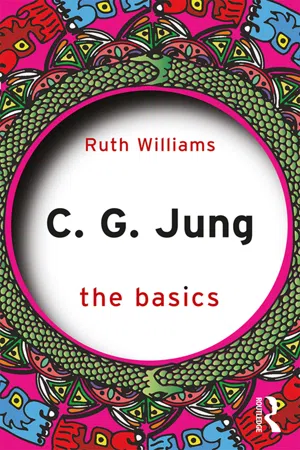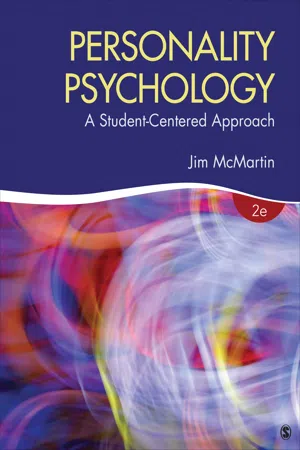Psychology
Personality Types
Personality types refer to the categorization of individuals based on their characteristic patterns of thoughts, feelings, and behaviors. These types are often used to understand and predict how people are likely to respond in various situations. They can be assessed through various personality tests and theories, such as the Myers-Briggs Type Indicator and the Big Five personality traits.
Written by Perlego with AI-assistance
Related key terms
7 Key excerpts on "Personality Types"
- eBook - ePub
Be A Better Leader
Personality Type And Difference In Ministry
- Graham Osborne(Author)
- 2016(Publication Date)
- SPCK(Publisher)
Part 1 INTRODUCING PSYCHOLOGICAL TYPE THEORYPassage contains an image Psychological type theory
It would seem sensible to start with what psychological type is all about. If you would rather pass over the different theories and go straight to the type profiles, please feel free to go on to Part Two of this book, pausing at p. 31 if you would like to discover, or check, your own type.The British Psychological Society defines ‘psychology’ as ‘the science of mind and behaviour’. Psychology is a very wide field and my focus in this book is on personality psychology, so how does one define ‘personality’? The definitions listed here are from both the academic world and generally available dictionaries.- Gordon Allport, who focused his studies on psychologically healthy individuals: ‘Personality is the dynamic organization within the individual of those psychophysical systems that determine his characteristic behavior and thought.’1
- Robert Stephen Weinberg and Daniel Gould in Foundations of Sport and Exercise Psychology : ‘the characteristics or blend of characteristics that make a person unique’.2
- Oxford Dictionaries online: ‘The combination of characteristics or qualities that form an individual’s distinctive character’.
- The Collins English Dictionary : ‘the sum total of all the behavioural and mental characteristics by means of which an individual is recognized as being unique’.
- Merriam-Webster online dictionary: ‘the set of emotional qualities, ways of behaving, etc., that makes a person different from other people’.
- American Psychological Association: ‘Personality refers to individual differences in characteristic patterns of thinking, feeling and behaving. The study of personality focuses on two broad areas: One is understanding individual differences in particular personality characteristics, such as sociability or irritability. The other is understanding how the various parts of a person come together as a whole.’3
- eBook - ePub
Behavioral Finance and Investor Types
Managing Behavior to Make Better Investment Decisions
- Michael M. Pompian(Author)
- 2012(Publication Date)
- Wiley(Publisher)
Whether we realize it or not, we describe and assess the personalities of the people around us on a daily basis. These daily musings about how and why people behave as they do are similar to what personality psychologists do. While our informal assessments of personality tend to focus more on individuals, personality psychologists instead use well-developed conceptions of personality that can apply to everyone. Personality research has led to the development of a number of theories that help explain how and why people act the way they do and why certain personality traits develop.While there are many different theories of personality, the first step is to understand exactly what is meant by the term personality . A brief definition is that personality is made up of the characteristic patterns of thoughts, feelings, and behaviors that make a person unique. In addition to this, personality arises from within the individual and remains fairly consistent throughout life.Some of the fundamental characteristics of personality include:- Consistency: There is generally a recognizable order and regularity to behaviors. Essentially, people act in the same ways or similar ways in a variety of situations.
- Psychological and physiological traits: Personality is a psychological construct, but research suggests that it is also influenced by biological processes and needs.
- Impact on behaviors and actions: Personality does not just influence how we move and respond in our environment; it also causes us to act in certain ways.
- Multiple expressions: Personality is displayed in more than just behavior. It can also be seen in our thoughts, feelings, close relationships, and other social interactions.
Now that we've described the basic components of personality known today, let's discuss the very beginnings of the study of personality and take a brief look at the discipline's first practitioners and their contributions to the more modern theorists. This takes us all the way back to Ancient Greece, around 400 b.c. - eBook - ePub
Personality and Intelligence at Work
Exploring and Explaining Individual Differences at Work
- Adrian Furnham(Author)
- 2008(Publication Date)
- Routledge(Publisher)
4 Types, temperaments and traits at workIntroduction
This chapter will look at three very different approaches to understanding and describing personality and its relation to the world of work. The first is neo-psychoanalytic in origin and attempts to describe personality in types. The second has a psychophysical origin and looks primarily at temperament and the physical functioning of personality. The third is psychometric in origin and looks at personality traits.It has been argued that there are three Ts in the evolution of personality scales. They are temperaments, types and traits. Temperaments have been measured in many ways but types and traits (often using the same language) differ, often because of the nature of the (well-known self-report) tests to measure them. Type measures are more of style than of core traits. They measure observable “outside” behaviour more than inner beliefs and motives. They are often theory driven and more concerned with being loyal to the theory than interested in the psychometric properties of scales.Applied researchers and human resource professionals often favour type measures as clients like them because they are easy to understand. Thus, people can be given a simple summary of their type. However, psychometricians have long moved on from categorical to dimensional systems noting that they offer much better measurement sensitivity and diagnostic accuracy. All human characteristics (with very few exceptions like handedness) are normally distributed and better measured dimensionally.Traits and types
It is always important to distinguish between traits and types. Types (e.g. gender), are regarded as categories of membership that are distinct and discontinuous. People are either the one or the other. In trait theories, people differ in amounts on a single continuum. Trait theorists see the difference between individuals quantitatively rather than qualitatively. Typologies are out of fashion because assignment has often proved to be too arbitrary and unreliable. After all, even gender is not absolutely perfect. Trait theories often talk in typological terms, but think of traits as continuously (often normally) distributed. One way to contrast the two is shown in Table 4.1 - eBook - ePub
C. G. Jung
The Basics
- Ruth Williams(Author)
- 2018(Publication Date)
- Routledge(Publisher)
People often get stuck on how they can trust their intuition, and whether what they are experiencing is indeed intuition. You might find it interesting to experiment with noting down in a journal what you think might be an intuition to see if it can be trusted. (Genuine intuition is always spot on, but can be confused with fear, anxiety or paranoid thinking.)One way to establish your own psychological type is to use the tool developed by Isabel Briggs Myers (1897–1980) and her mother Katharine Cook Briggs (1875–1968) called the Myers-Briggs Type Indicator® , which is used by many businesses and others to enable individuals to grow through an understanding and appreciation of individual differences and to enhance harmony and productivity in diverse groups. See www.myersbriggs.org/my-mbti-personality-type/ , accessed 20 June 2015. (Please note that it does cost to do this test although it is possible you may find a free version.) It is important to realise that there is no ‘good’ or ‘bad’ type. They are all equal and indicate different propensities. The purpose of the tool is more to evaluate preferences or tendencies. It does not measure ability or character in a critical way. It is more helpful to think about the personality type as a way of understanding yourself and as a guide in thinking about how you make choices.It is possible to dismiss Jung’s theories of psychological types as a superficial schema which at first glance seems quite concrete and unsubtle. But, as with many of Jung’s theories, it is possible to explore with increasing depth and to see them as much more complex and nuanced than at first glance. The types can be seen as a parlour game or like a horoscope, categorising things in quite generalised blocks of information applied to vast swathes of the population. It is also possible to get a more refined understanding of someone’s psychological type in a very personal way. So for example, while the author is an Extraverted Feeling type, in fact she is an introvert but her feeling function is so prominent it becomes an extraverted function. Jung did not use this system to label people, but rather as a critical apparatus to sort and organise the welter of empirical data (Jung 1934 pp. xiv). - eBook - ePub
Personality Psychology
A Student-Centered Approach
- James (Jim) A. McMartin(Author)
- 2016(Publication Date)
- SAGE Publications, Inc(Publisher)
These dispositions are revealed in a person’s consistent and distinctive behavior across a variety of different situations. Traits dispose us to behave in similar ways throughout our lives. When we perceive differences in the personalities of our friends and acquaintances, we are seeing differences in their traits: Jack is friendlier than Tom, but Tom is more conscientious than Jack. Do you want to have a good time? Call Jack. Do you want to get your work done on time? Call Tom. Photo 1.1 Gordon Allport (1897–1967) Allport, a vigorous proponent of personality traits, proposed the distinction between nomothetic and idiographic approaches. Allport is the single most important person in the history of the scientific study of personality. Key publications: Personality: A Psychological Interpretation (1937) The Nature of Prejudice (1954) Pattern and Growth in Personality (1961) Traits are sometimes confused with types. In everyday language, we might hear someone say, “He’s the type of person who …” Strictly speaking, a type refers to a distinctive category so that a person either fits into that category or does not. For example, some people have Type A blood, while others have Type B, AB, or Type O. These are discrete, qualitatively different, types of blood. There is no middle ground and there is no range within types. One person with Type A blood does not have more or less Type A blood than others. Adding more Type A blood will not produce Type B blood. A trait, however, unlike a yes-or-no type, refers to a range of possible dispositions. The trait of agreeableness, for example, ranges from extremely agreeable to extremely disagreeable. Everyone’s personality will fall somewhere in this range. Most people’s personality test scores are near the middle of the range on most traits. When personality psychologists designate a trait by a single term—extraversion, agreeableness, honesty—the designation refers to one pole of the trait, while its opposite pole is implied - eBook - ePub
Understanding and Changing Your Management Style
Assessments and Tools for Self-Development
- Robert C. Benfari(Author)
- 2013(Publication Date)
- Jossey-Bass(Publisher)
Chapter Two
Psychological Type
A Cognitive Approach
Jung's classic treatise Psychological Types (1921/1976) is the backbone of the Myers-Briggs Type Indicator (MBTI). After World War II, Katherine Briggs and Isabel Briggs Myers, a mother-daughter team, designed the MBTI as a vehicle for assessing the psychological types Jung had described in his treatise. Jung and his followers had delved into the subject of psychological types with clinical thoroughness, meticulously describing their findings. But much that is currently written about Jungian typology misinterprets Jung's work. For example, some authors have linked independent factors, such as needs and conflict styles, to the types, which muddles their usefulness as templates. They also have assigned to particular types behaviors that are not always present. Therefore, it is important to look at Jung's original theories closely.The Background
Jung was both an empiricist and a phenomenologist. This means that he observed behavior both in its consistencies and in its incongruities, then described it in terms of a structured approach to personality organization. He compared his observations in the present, based on clinical data, with his studies of the past, based on a thorough review of myths and religious symbols relating to what he called the “type problem.” Jung was convinced that the psychological types he found in his clinical observations had counterparts in literature, mythology, history, philosophy, and biography. He published his intuitively conceived theory of psychological types in 1920. The first English edition, prepared by his devoted disciple Peter Baynes, was published in 1923, but the treatise received only a modest amount of attention.Jung's seminal work on Personality Types remained relatively unknown for more than forty years. Why was the world so slow to discover his theories? A number of possible reasons present themselves. First of all, in 1923, other approaches to psychology were dominant in Europe and North America. Freudian psychology was in vogue in Europe and on both American coasts, and grassroots America was under the overwhelming influence of behaviorism. Scientific circles of the time regarded Jung as mystical and his approach as antithetical to their own penchant for logic and facts. In later life, Jung grew more and more interested in the spiritual and religious aspects of psychology, and increasing numbers of psychologists wrote him off as unscientific. But today we are returning to Jung's way of thinking. Books like M. Scott Peck's The Road Less Traveled - eBook - ePub
- Paul Smith, Marilyn Farmer, Wendy Yellowley(Authors)
- 2013(Publication Date)
- Routledge(Publisher)
When we meet someone for the first time, we often form immediate impressions based on very limited information. Perhaps the clothes they are wearing, the way they talk or even the firmness of their handshake will start to form a picture in our mind about what this person might be like. If we continue to get to know the person, it is more likely that we will adapt our first impressions and begin to base our estimation of the person on his or her more consistent and enduring ways of behaving. So personality refers to the unique characteristics that determine and influence how people act and behave.The sort of experience described above is the focus of this particular chapter; the implications of individual personality, the process of perception and how we form attitudes hold much relevance for organizational life.3.2 Individual differences and personality
KEY TERM Personality:the characteristics of an individual that make the individual unique and shape his or her behaviour.Reflective questionsThere is much debate centred on whether personality is inherited (nature) or developed in response to environmental conditions (nurture). Which side of the debate would you support, and why?If you were to ask a friend to use three words to describe you, what do you think they would be? If you were to ask a colleague at work to use three words to describe you, what do you think they would be? Do they differ? If so, why might this be?All individuals are unique, but although we are all different, we all share several things. Research into personality has provided a fascinating wealth of material about which there remains controversy and debate. This chapter will attempt to provide a snapshot of the varying explanations of personality to whet the reader's appetite.The study of personality dates back to the Middle Ages, when the first examples of personality theory suggested that personality was linked to our physiological make-up and the balance of our bodily fluids. People were characterized as having a cheerful, energetic and lively personality if they had a greater amount of blood, while those with a higher level of phlegm were said to be typically calm and placid. Those with a lot of ‘black bile’ were classified as gloomy individuals, and those with more yellow bile were said to be aggressive and hasty. This sort of approach to personality attempted to provide a classification or typology system in which every individual could fit. Since then, other researchers, such as Sheldon (1954), have attempted to produce typologies of personality, using bodily shape as an indicator of personality type, with the mesomorph (athletic, muscular people), endomorph (plump, rounded people) and ectomorph (thin, fragile people) being the main indicators.
Learn about this page
Index pages curate the most relevant extracts from our library of academic textbooks. They’ve been created using an in-house natural language model (NLM), each adding context and meaning to key research topics.






